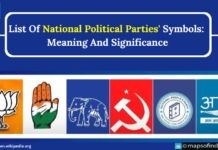Established in 1852, the Geological Survey of India (GSI) is a Government organization attached to the Ministry of Mines of Union Government of India and conducts geological surveys and studies. One of the oldest among similar organizations in the world and second oldest in the country, GSI is the prime provider of basic earth science to the government, industry and public. When it was first established in 1852, the main responsibility of GSI was to create an effective geological map of the country which would enable it to explore for coal (which was the basic fuel of the steam powered colonial era) and other ores. Absence of Radiocarbon Dating and poor technology made the job extremely laborious and time consuming. GSI then had to depend on the technique of “index fossils” to determine the ages of the rock layers and other allied data to determine possible deposits of coal and other important ores.
GSI has come a long way from fossil indexing of rock strata to the present day’s indispensable part of the scientific realm of our country. The various flourishing industries of India like steel, coal, metal, cement and the power plants are hugely indebted to the tireless contributions of GSI, outlining the importance of GSI in the national context. Earth science is a highly diverse and multifarious stream of science and so the responsibilities entrusted to GSI are enormous. It is evident that GSI has faced numerous challenges but had never lagged behind to redesign its infrastructure to suit the needs of the time and has grown from strength to strength keeping in tandem with the HPC norms and also maintaining its social importance.
The functions of GSI are so multifaceted that it is rather impossible to discuss them in detail due to space constraints. One of the basic responsibilities of GSI is of course leading explorations to examine in detail the various potential earth strata and discovering new mineral deposits which in turn play an important role in the industrial development and expansion. The extensive mineral mapping achieved by GSI of our country provides vital earth science information not only to GSI but other scientific institutes and R&D organizations as well. GSI’s contribution in the field of seismology is also undeniable. So far the organization has provided indispensable data on the various earthquakes that has affected our country since the last five decades till date demarcating the earthquake sensitive zones and their possible causes. The contribution of GSI in the field of developing natural energy resources (except oil and gas) is also undeniable.
GSI also plays an important role in determining the causes of various natural disasters related to landslides and other allied disasters involving the earth strata, mountains, hill areas and man-made disasters owing to the violation of eco-sensitive zones and the possible ways to arrest such calamities. For example Western Ghats especially the Nilgiris is an extremely landslide prone zone. Frequent cases of landslide cause extensive damage to this area and are a source of constant peril to its inhabitants. GSI has taken up the responsibility of a “hazard zone mapping” and permanent resettlement of the inhabitants of this region to a relatively safe zone. To achieve this GSI plans to set up workshops to increase awareness and has contacted the important officials and major stakeholders of the southern states who are also scheduled to attend the workshop. The Uttarakhand Tragedy is likely to be investigated by GSI thoroughly. An immediate workshop was set up by GSI on a regional basis after the Uttarakhand tragedy in Shimla followed by another in Shillong to create awareness among the north eastern states to prevent such further man-made calamities that essentially has its roots in illegal construction in eco-sensitive zones and plundering of the mountain slopes through thoroughly unscientific constructions. GSI has been proactive in predicting such natural calamities in the past and lending a deaf ear to the advices of GSI regarding construction on the hill slopes of the Nilgiris to the Tamil Nadu Government had triggered one of the worst landslides in 2009. A massive landslide occurred in the Chinnabikatty section of the National Highway in Coonor that had rendered the highway inoperable for nearly two months.
Despite the impressive track records of GSI, there is immense room for improvements as GSI still seems to suffer partially from the colonial hangover. The equipment used by GSI are actually antiquated and cumbersome to move around with which need to be replaced by modern and lighter equipment that are also easy to maneuver. Explorations should be bolstered by the increased use of Internet, laptops and palmtops. Proper use of the earth observing satellites for mapping purposes is lacking. Besides special exploration vehicles with satellite connection are also necessary especially in the North Eastern regions of our country. The internal administrative structure of GSI is very complex which further slows down the activities of the organization. Fund shortage in any sector is a ubiquitous problem of our government and so right funding for explorations at the right place and at the right time is seldom available.
However, in spite of the drawbacks of GSI, the 36th International Geological Congress (IGC) will be held in New Delhi in 2020. Originally scheduled to be held in Canada, Canada was voted out in favour of India. The convention will be attended by 10,000 delegates from all over the world and this indeed is a very prestigious issue for India.
This shows that in spite of its antiquities, GSI still holds an important position in the ‘international geoscientific fora’ and it’s the duty of our Government to help this competent institution in every way so that GSI can have the competitive edge to become one of the top geoscientific research organizations in the whole world.



